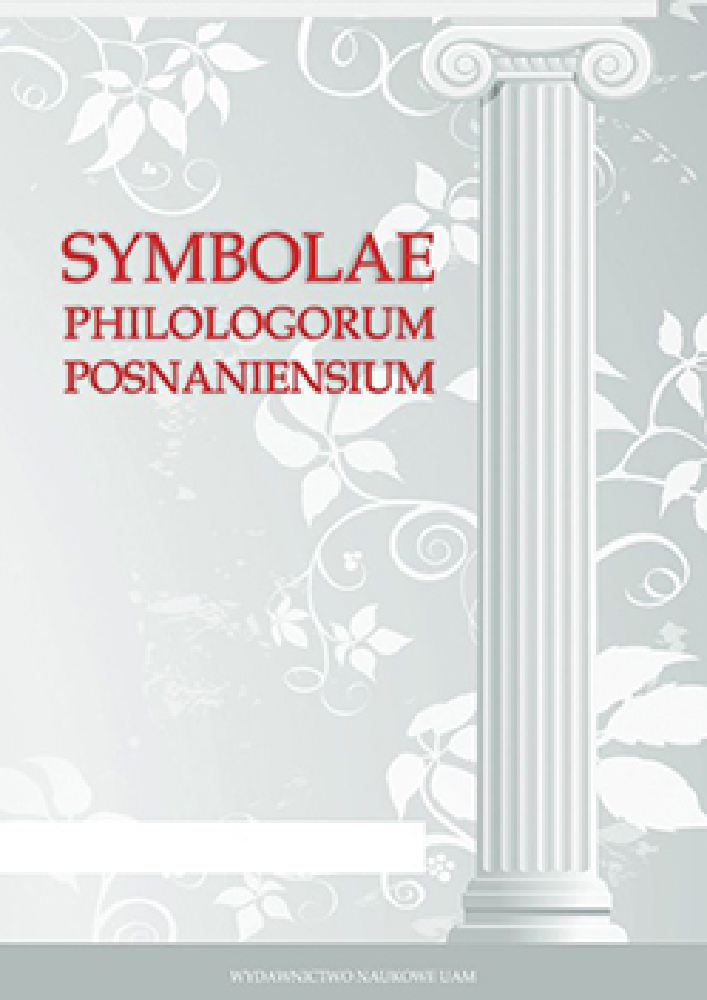Abstrakt
The paper examines a number of Roman literary texts (by Ennius, Cicero, Vergil, Ovid, Seneca the Younger, Lucan, Tacitus, Jerome, etc.) in which viewing is connected with mental or emotional suffering. Usually, the emphasis is laid on a character’s viewing of some dramatic events – a close relative’s death, for example – and on his or her emotional response to what is being seen. In some works, especially in consolatory contexts, someone’s premature death is presented as advantageous because the dead person is now spared the necessity of viewing misfortunes which the living have to witness. Also, people may be compelled (e.g. by an emperor) to watch evil things; in such a situation they are usually viewers and objects of viewing at the same time, since their gestures and facial expression are carefully observed.
Bibliografia
Źródła, przekłady, komentarze
Cornelio Tacito, Agricola, introduzione, testo critico, traduzione e commento a cura di P. Soverini, Alessandria 2004 [= Soverini 2004].
E. Courtney, A Commentary on the Satires of Juvenal, London 1980.
Ennius, The Tragedies. The Fragments, ed. by H.D. Jocelyn, Cambridge 1969 [= Jocelyn 1969].
Eurypides, Tragedie, t. II: Andromacha, Oszalały Herakles, Trojanki, Elektra, Ifigenia w kraju Taurów, Ijon, przeł. J. Łanowski, przekład przejrzała J. Ławińska-Tyszkowska, wyd. II, Warszawa 2006.
Heliodor, Opowieść etiopska o Theagenesie i Chariklei, przekł., wstęp i oprac. S. Dworacki, Poznań 2000.
Lucan, De Bello Civili, Book II, ed. by E. Fantham, Cambridge 1992 [= Fantham 1992].
J.H.D. Scourfield, Consoling Heliodorus. A Commentary on Jerome, Letter 60, Oxford 1993.
Tacitus, Agricola, ed. by A.J. Woodman, with Contributions from C.S. Kraus, Cambridge 2014 [= Woodman, Kraus 2014].
Opracowania
Audano 2015: S. Audano, Sopravvivere senza l’adilà. La consolatio laica di Tacito nell’Agricola, w: Le parole dopo la morte. Forme e funzioni della retorica funeraria nella tradizione greca e romana, red. C. Pepe, G. Moretti, Trento 2015, 245–288.
Backhaus 2019: M. Backhaus, Mord(s)bilder – Aufzahlungen von Gewalt bei Seneca und Lucan, Berlin–Boston 2019.
Bal 2012: M. Bal, Narratologia. Wprowadzenie do teorii narracji, Kraków 2012.
Bartsch 1994: S. Bartsch, Actors in the Audience. Theatricality and Doublespeak from Nero to Hadrian, Cambridge, MA–London 1994.
Ben-Porat 1988: Z. Ben-Porat, Poetyka aluzji literackiej, przeł. M. Adamczyk-Garbowska, „Pamiętnik Literacki” LXXIX/1 (1988), 315–337.
Berno 2004: F.R. Berno, Un truncus, molti re. Priamo, Agamennone, Pompeo (Virgilio, Seneca, Lucano), „Maia” LVI (2004), 79–84.
Bowie 1990: A.M. Bowie, The Death of Priam: Allegory and History in the Aeneid, „Classical Quarterly” XL (1990), 470–481.
Brena 1993: F. Brena, Das Blut und die Flamme. Anmerkung zu Lucan 2, 126–129, „Rheinisches Museum” CXXXVI (1993), 307–321.
Briggs 1980: W.W. Briggs, Jr., Narrative and Simile from the Georgics in the Aeneid, Leiden 1980.
Bühler 1976: W. Bühler, Das Element des Visuellen in der Eingangsszene von Heliodors Aithiopika, „Wiener Studien” LXXXIX (1976), 177–185.
Degl’Innocenti Pierini 2003: R. Degl’Innocenti Pierini, Cicerone nella prima età imperiale. Luci ed ombre su un martire della repubblica, w: Aspetti della fortuna di Cicerone nella cultura latina. Atti del III Symposium Ciceronianum Arpinas, Arpino 10 maggio 2002, red. E. Narducci, Firenze 2003, 3–54.
Dworacki 1996: S. Dworacki, Theatre and Drama in Heliodorus’ Aethiopika, „Eos” LXXXIV (1996), 355–361.
Elliott 2008: J. Elliott, Ennian Epic and Ennian Tragedy in the Language of the Aeneid. Aeneas’ Generic Wandering and the Construction of the Latin Literary Past, „Harvard Studies in Classical Philology” CIV (2008), 241–272.
Esteve-Forriol 1962: J. Esteve-Forriol, Die Trauer- und Trostgedichte in der römischen Literatur untersucht nach ihrer Topik und ihrem Motivschatz, diss. München 1962.
Genette 1972: G. Genette, Figures III, Paris 1972.
Hunter 2009: R. Hunter, Critical Moments in Classical Literature. Studies in the Ancient View of Literature and its Uses, Cambridge 2009.
de Jong 1987: I.J.F. de Jong, Narrators and Focalizers: The Presentation of the Story in the Iliad, Amsterdam 1987.
de Jong 2014: I.J.F. de Jong, Narratology and Classics: A Practical Guide, Oxford 2014.
Kassel 1958: R. Kassel, Untersuchungen zur griechischen und römischen Konsolationsliteratur, München 1958.
Keitel 2007: E. Keitel, Feast Your Eyes on This: Vitellius as a Stock Tyrant (Tac. Hist. 3.36–39), w: A Companion to Greek and Roman Historiography, red. J. Marincola, Malden 2007, 441– 446.
Knox 1950: B.M.W. Knox, The Serpent and the Flame: The Imagery of the Second Book of the Aeneid, „American Journal of Philology” LXXI (1950), 379–400.
Lee 1979: M.O. Lee, Fathers and Sons in Virgil’s Aeneid: tum genitor natum, Albany 1979.
Lohikoski 1966: K.K. Lohikoski, Der Parallelismus Mykene–Troja in Senecas „Agamemnon”, „Arctos” IV (1966), 63–70.
Murgatroyd 2016: P. Murgatroyd, Juvenal, Virgil and the Death of Priam, „Latomus” LXXV (2016), 183–186.
O’Sullivan 2009: T.M. O’Sullivan, Death ante ora parentum in Virgil’s Aeneis, „Transactions of the American Philological Association” CXXXIX (2009), 447–486.
Petrone 2008: G. Petrone, La „fragile fortuna” di Priamo e Pompeo. Uno schema tragico d’interpretazione, „Maia” LX (2008), 51–63.
Pigoń 2004: J. Pigoń, Ze studiów nad technikami narracyjnymi Tacyta. Wypowiedzi proleptyczne, Wrocław 2004.
Rivoltella 2005: M. Rivoltella, Le forme del morire. La gestualità nelle scene di morte dell’Eneide, Milano 2005.
Schmitzer 2005: U. Schmitzer, Der Tod auf offener Szene. Tacitus über Nero und die Ermordung des Britannicus, „Hermes” CXXXIII (2005), 337–357.
Scholes, Kellogg 1966: R. Scholes, R. Kellogg, The Nature of Narrative, Oxford 1966.
Schwerdtner 2015: K. Schwerdtner, Plinius und seine Klassiker. Studien zur literarischen Zitation in den Pliniusbriefen, Berlin–Boston 2015.
Stabryła 1970: S. Stabryła, Latin Tragedy in Virgil’s Poetry, Wrocław 1970.
Stahl 1981: H.-P. Stahl, Aeneas – an „Unheroic” Hero?, „Arethusa” XIV (1981), 157–177.
Syme 1958: R. Syme, Tacitus, Oxford 1958.
Telò 2011: M. Telò, The Eagle’s Gaze in the Opening of Heliodorus’ Aethiopica, „American Journal of Philology” CXXXII (2011), 581–613.
Tzounakas 2018: S. Tzounakas, Seneca’s Hecuba and Lucan’s Cornelia, „Pan” VII (2018), 95–112.
Whitmarsh 1992: T. Whitmarsh, Written on the Body: Ekphrasis, Perception and Deception in Heliodorus’ Aethiopica, „Ramus” XXXI (2002), 111–125.
Wigodsky 1972: M. Wigodsky, Vergil and Early Latin Poetry, Wiesbaden 1972.
Winter 2014: K. Winter, Artificia mali. Das Böse als Kunstwerk in Senecas Rachetragödien, Heidelberg 2014.
Licencja

